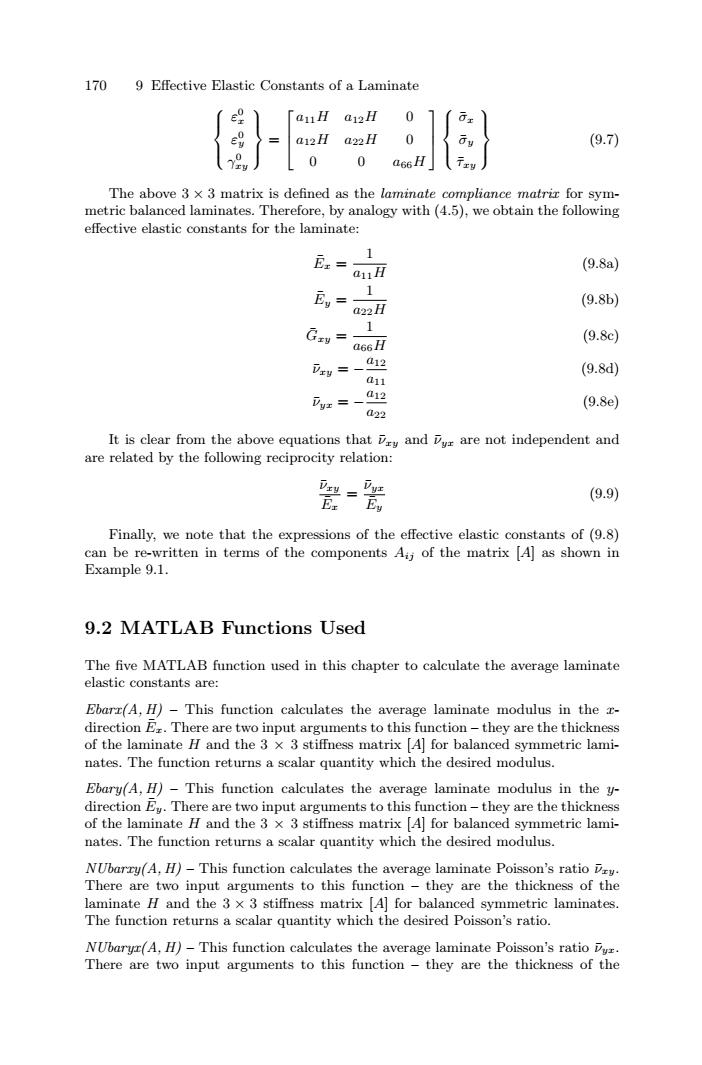正在加载图片...

170 9 Effective Elastic Constants of a Laminate anH a12H 0 a12H a22H 0 (9.7) 0 0 a66 H The above 3 x 3 matrix is defined as the laminate compliance matrir for sym- metric balanced laminates.Therefore,by analogy with (4.5),we obtain the following effective elastic constants for the laminate: E:= 1 anH (9.8a) Ev= 1 a22H (9.8b) Gav= 1 (9.8c) a66H y=-012 (9.8d) a11 iyx=一 412 (9.8e) a22 It is clear from the above equations that Dry and Dyr are not independent and are related by the following reciprocity relation: 型=华 E Ev (9.9) Finally,we note that the expressions of the effective elastic constants of(9.8) can be re-written in terms of the components Aij of the matrix [A]as shown in Example 9.1. 9.2 MATLAB Functions Used The five MATLAB function used in this chapter to calculate the average laminate elastic constants are: Ebarr(A,H)-This function calculates the average laminate modulus in the r- direction Ez.There are two input arguments to this function-they are the thickness of the laminate H and the 3 x 3 stiffness matrix [A]for balanced symmetric lami- nates.The function returns a scalar quantity which the desired modulus. Ebary(A,H)-This function calculates the average laminate modulus in the y- direction Ey.There are two input arguments to this function-they are the thickness of the laminate H and the 3 x 3 stiffness matrix [A]for balanced symmetric lami- nates.The function returns a scalar quantity which the desired modulus. NUbarry(A,H)-This function calculates the average laminate Poisson's ratio Dy. There are two input arguments to this function-they are the thickness of the laminate H and the 3 x 3 stiffness matrix [A]for balanced symmetric laminates. The function returns a scalar quantity which the desired Poisson's ratio. NUbaryr(A,H)-This function calculates the average laminate Poisson's ratio uz. There are two input arguments to this function-they are the thickness of the170 9 Effective Elastic Constants of a Laminate ⎧ ⎪⎨ ⎪⎩ ε0 x ε0 y γ0 xy ⎫ ⎪⎬ ⎪⎭ = ⎡ ⎢ ⎣ a11H a12H 0 a12H a22H 0 0 0 a66H ⎤ ⎥ ⎦ ⎧ ⎪⎨ ⎪⎩ σ¯x σ¯y τ¯xy ⎫ ⎪⎬ ⎪⎭ (9.7) The above 3 × 3 matrix is defined as the laminate compliance matrix for symmetric balanced laminates. Therefore, by analogy with (4.5), we obtain the following effective elastic constants for the laminate: E¯x = 1 a11H (9.8a) E¯y = 1 a22H (9.8b) G¯xy = 1 a66H (9.8c) ν¯xy = −a12 a11 (9.8d) ν¯yx = −a12 a22 (9.8e) It is clear from the above equations that ¯νxy and ¯νyx are not independent and are related by the following reciprocity relation: ν¯xy E¯x = ν¯yx E¯y (9.9) Finally, we note that the expressions of the effective elastic constants of (9.8) can be re-written in terms of the components Aij of the matrix [A] as shown in Example 9.1. 9.2 MATLAB Functions Used The five MATLAB function used in this chapter to calculate the average laminate elastic constants are: Ebarx(A, H) – This function calculates the average laminate modulus in the xdirection E¯x. There are two input arguments to this function – they are the thickness of the laminate H and the 3 × 3 stiffness matrix [A] for balanced symmetric laminates. The function returns a scalar quantity which the desired modulus. Ebary(A, H) – This function calculates the average laminate modulus in the ydirection E¯y. There are two input arguments to this function – they are the thickness of the laminate H and the 3 × 3 stiffness matrix [A] for balanced symmetric laminates. The function returns a scalar quantity which the desired modulus. NUbarxy(A, H) – This function calculates the average laminate Poisson’s ratio ¯νxy. There are two input arguments to this function – they are the thickness of the laminate H and the 3 × 3 stiffness matrix [A] for balanced symmetric laminates. The function returns a scalar quantity which the desired Poisson’s ratio. NUbaryx(A, H) – This function calculates the average laminate Poisson’s ratio ¯νyx. There are two input arguments to this function – they are the thickness of the